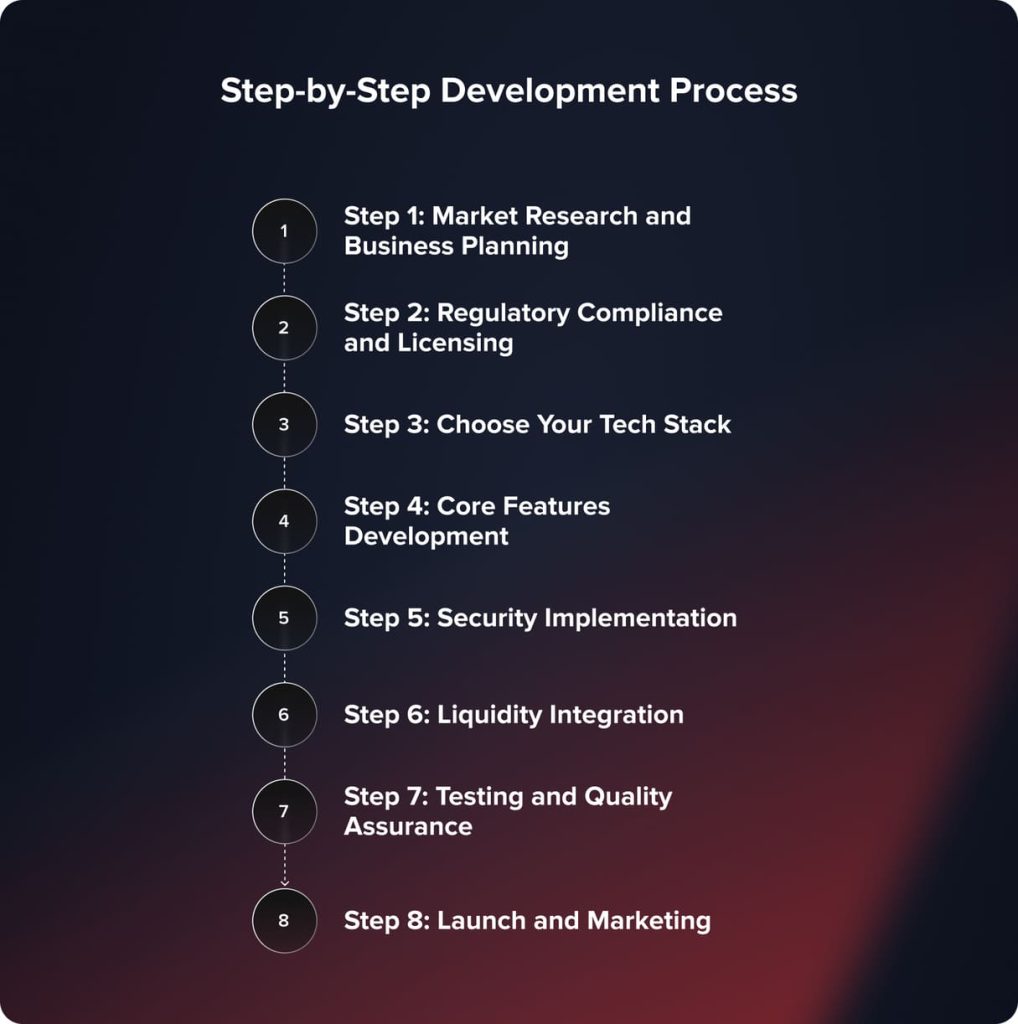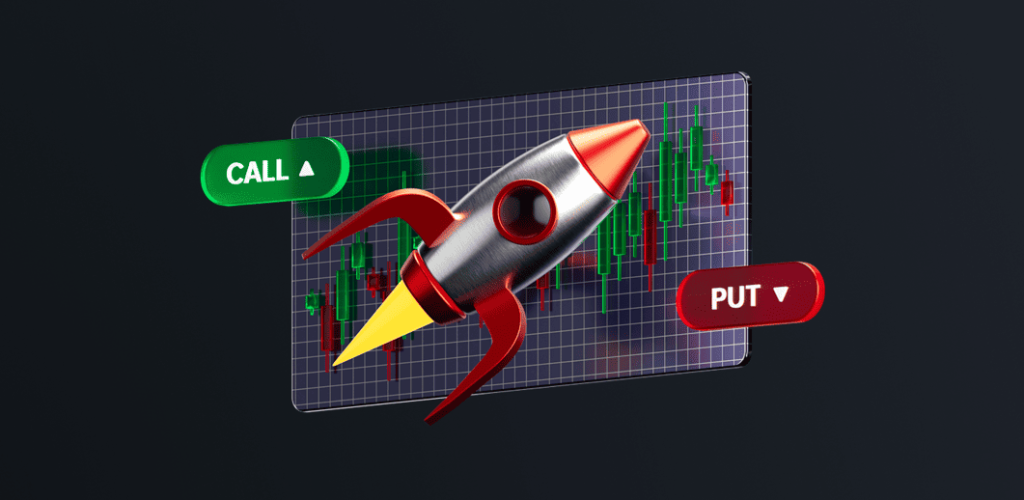
Разработка торговой платформы: Как создать шаг за шагом?
В статье
Создание торговой платформы в 2026 году требует внимательного планирования, надежной технологии и соблюдения нормативных требований для доступа к рынку, который по оценкам, вырастет до 17,42 миллиарда долларов к 2033 году. Рынок онлайн-торговых платформ по всему миру растет на 5,39% в год, катализатором является увеличение участия розничных инвесторов и технологии торговли на основе ИИ. Ваша платформа должна предлагать обновления в реальном времени, мгновенное исполнение и безопасность корпоративного уровня, чтобы эффективно конкурировать в этой новой среде.
Что такое торговая платформа?
Торговая платформа — это цифровая инфраструктура, которая объединяет покупателей и продавцов на финансовых рынках для облегчения транзакций с акциями, валютой, товарами и/или криптовалютами. Платформы получают миллионы заказов ежедневно, предоставляя возможности для построения графиков, анализа рынка и управления портфелем. Современные платформы интегрируют аналитические данные на основе ИИ, автоматизацию алгоритмической торговли и поддержку различных активов для удовлетворения потребностей различных трейдеров.
Различие между типами платформ имеет значение. Биржевые платформы обеспечивают сопоставление ордеров между равными участниками с помощью двигателей сопоставления ордеров, а брокерские платформы выступают в роли посредников между трейдерами и поставщиками ликвидности.
Хотя некоторые строят с нуля, рекомендуется воспользоваться Решениями с белой маркой, которые включают в себя предварительно настроенную инфраструктуру, которую вы можете настроить и брендиовать, сокращая время разработки с лет до недель.
Обзор рынка и статистика
Размер рынка онлайн-трейдинговых платформ достиг $10.82 миллиардов в 2025 году и, как ожидается, вырастет до $16.71 миллиардов к 2032 году, с годовым темпом роста 6.4%. Североамериканский регион доминировал на рынке благодаря сильному принятию технологий и надежной финансовой инфраструктуре.
Розничный объем стремительно вырос, составив более 23% от общего объема торгов на рынке в 2023 году благодаря торговле без комиссий и дробным акциям. Демократизация рынков предоставляет возможности для новых платформ, чтобы выступать посредниками, и для новых трейдеров. Торговые платформы, использующие технологии ИИ, демонстрируют взрывной рост, так как анализ рынка прогнозирует, что рынок вырастет с $22.3 миллиарда в 2025 году до $50.4 миллиарда к 2033 году.
Для получения дополнительной информации ознакомьтесь с нашим постом на тему “Роль искусственного интеллекта в торговых платформах”.
Пошаговый процесс разработки

Шаг 1: Исследование рынка и бизнес-планирование
Ваше исследование рынка должно определить целевые рынки, географическое положение и тип конкурентов, прежде чем вы начнете писать код. Подумайте, хотите ли вы специализироваться на форекс, акциях, криптовалюте или многосистемной торговле, так как каждое направление имеет свои особенности ликвидности и регуляторные требования. Изучите успешные модели, такие как мобильная платформа Robinhood или функциональность профессионального уровня Interactive Brokers, чтобы выявить области недостатков на рынке.
Четко укажите ваше ценностное предложение. Вы конкурируете на основе нулевых комиссий, более высокой скорости исполнения, образовательного контента или функций социального трейдинга? Ваша бизнес-модель влияет на требования к технологиям – модели оплаты за поток заказов требуют другой инфраструктуры, чем платформы на основе подписки. Создайте детализированные финансовые прогнозы для затрат на разработку, операционных расходов и средств на привлечение клиентов на три года.
Шаг 2: Регулирование и лицензирование
Соблюдение регулирования является основой устойчивых операций для торговых платформ. SEC и FINRA вводят повышение сборов, которое приведет к дополнительным $450 миллионов ежегодных сборов к 2029 году, одновременно расширяя контроль за развертыванием ИИ и внеканальной коммуникацией. Ваша стратегия лицензирования различается в зависимости от целевых рынков – ЕС требует соблюдения регулирования с MiFID II, в то время как платформы США нуждаются в регистрации SEC и FINRA.
Разные юрисдикции имеют различную степень регуляторной сложности и доверия. Хорошо зарекомендовавшие себя регуляторные климатические условия для международного бизнеса существуют на Кипре (CySEC), в Великобритании (FCA) и в Австралии (ASIC). Оффшорные схемы, такие как Сейшельские Острова или Британские Виргинские Острова, быстрее лицензируются, но ограничивают доступ к определенным рынкам. Инвестируйте от 50,000 долларов для оффшорных схем и от 150,000 долларов и более для полного регулирования ЕС.
Реализуйте протоколы KYC (Знай своего клиента) и AML (Противодействие отмыванию денег) с первого дня. Это не второстепенные вещи, а неотъемлемая функциональность платформы, которая защищает ваш бизнес от регуляторных штрафов. Интегрируйте продукты для проверки личности, такие как Sumsub или Jumio, чтобы оптимизировать процесс onboarding, сохраняя при этом соответствие требованиям.
Вам также может понравиться

Шаг 3: Выберите свой технологический стек
Ваши выборы технологического стека напрямую влияют на производительность платформы, масштабируемость и стоимость разработки. Либо Angular, либо React обеспечивают отзывчивые интерфейсы для фронтенд-разработки, а Flutter или React Native предоставляют кросс-платформенную разработку мобильных приложений. Инфраструктура бэкенда, вероятно, использует Node.js для управления данными в реальном времени или Java для масштабирования до уровня корпоративных решений с максимальными требованиями к стабильности.
Выбор базы данных включает объем транзакций и потребности в целостности данных. PostgreSQL предлагает надежную поддержку реляционных баз данных для учетных записей пользователей и истории транзакций, а Redis предлагает кэширование данных о ценах в реальном времени в памяти. Базы данных NoSQL, такие как MongoDB, эффективно обрабатывают неструктурированные рыночные данные.
Облачный хостинг на AWS, Google Cloud или Microsoft Azure предлагает гибкость и географический охват для доступа с низкой задержкой. Облачные развертывания являются ведущим двигателем и быстро растут, при этом платформы обрабатывают потоки заказов с задержкой менее миллисекунды через безсерверные фреймворки. Программное обеспечение для форекс-брокеров требует специализированных элементов, таких как системы управления заказами, программное обеспечение для управления рисками и платформы для операций бэк-офиса.
Шаг 4: Разработка основных функций
Торговый интерфейс и выполнение заказов
Ваш торговый интерфейс должен отображать котировки в реальном времени с точностью до миллисекунды и поддерживать несколько типов ордеров, включая рыночные, лимитные, стоп-лосс и трейлинг-стоп ордера. Примените торговлю в один клик для опытных трейдеров, которым необходимо быстрое исполнение, компенсированное диалогами подтверждения для новичков, чтобы предотвратить дорогостоящие ошибки. Ваш интерфейс также должен адаптироваться к различным уровням опыта с помощью настраиваемых параметров сложности и дизайна макета.
Скорость исполнения заказов напрямую влияет на удовлетворенность пользователей и результаты торговли. Создавайте системы сопоставления, которые исполняют заказы за микросекунды, с резервированием, чтобы торговля оставалась непрерывной даже в периоды максимальной волатильности. Поддерживаются как режимы мгновенного исполнения, так и режимы запроса цены, что дает вам гибкость в зависимости от различных классов активов и рыночных условий.
Чарты и технический анализ
Промышленные возможности построения графиков отличают конкурентные платформы от базовых. Включите библиотеки, такие как TradingView, или реализуйте собственное построение графиков с помощью D3.js, предлагая более 50 технических индикаторов, таких как скользящие средние, полосы Боллинджера, RSI и MACD. Несколько временных интервалов, начиная от тик-графиков и заканчивая месячными, подходят для различных торговых стилей, от скальпинга до позиционной торговли.
Инструменты рисования для трендовых линий, уровней коррекции Фибоначчи и паттернов помогают трейдерам проводить технический анализ на графиках. Пользователи могут сохранять пользовательские шаблоны и индикаторы, чтобы легко добавлять свои любимые анализы для различных инструментов.
Управление портфелем и аналитика
Большие панели управления портфелем показывают текущие позиции, нереализованную прибыль/убыток и исторические показатели эффективности. Рассчитайте доходность с учетом риска, используя коэффициенты Шарпа и максимальные показатели просадки, которые ожидают институциональные трейдеры. Поддержка нескольких счетов и портфелей позволяет пользователям сегментировать торговые стратегии или управлять счетами членов семьи.
История транзакций с полными записями о сделках, распределением комиссий и функциями налоговой отчетности снижает административную нагрузку для занятых трейдеров. Экспорт в CSV и PDF позволяет проводить внешний анализ и подготовку налогов.
Вам также может понравиться

Шаг 5: Реализация безопасности
Нарушения безопасности компрометируют целостность платформы и подвергают вас огромным юридическим рискам. Шифруйте все передаваемые данные с использованием SSL/TLS шифрования, с закреплением сертификатов в мобильных приложениях, чтобы сопротивляться атакам "человек посередине". Храните чувствительную информацию, зашифрованную с помощью AES-256 в состоянии покоя, с отдельными ключами шифрования для различных типов разнообразных данных, обрабатываемых через аппаратные модули безопасности (HSM).
Двухфакторная аутентификация (2FA) должна быть обязательной для вывода средств и должна быть доступна для входа через TOTP-приложения, такие как Google Authenticator, или SMS, с биометрической проверкой на мобильных устройствах, что обеспечивает удобство без ущерба для безопасности. Управление сессиями с автоматическим завершением и уведомления об идентификации устройств предупреждают пользователей о несанкционированных попытках доступа.
Регулярное проникновение тестирования сертифицированными компаниями по безопасности выявляет уязвимости до того, как такие уязвимости будут использованы злоумышленниками. Инициативы по вознаграждению за ошибки компенсируют этичным хакерам за ответственное сообщение о уязвимостях безопасности. Поддерживайте покрытие киберстрахования от атак на данные и разрушения бизнеса.
Шаг 6: Интеграция ликвидности
Ликвидность определяет качество исполнения, ценовую конкурентоспособность и экспозицию активов на вашей платформе. Для форекс и CFD платформ установите нескольких поставщиков ликвидности, таких как основные брокеры и банки, чтобы консолидировать лучшие цены на покупку/продажу. Умные алгоритмы маршрутизации заказов будут автоматически разделять крупные заказы между поставщиками, чтобы минимизировать влияние на рынок и оптимизировать исполнение.
Криптовалютные биржи требуют интеграции обмена или подключений API к пулам ликвидности. Используйте как API централизованных бирж, таких как Binance или Coinbase Pro, так и децентрализованные агрегаторы ликвидности. Платформы для торговли акциями предполагают подключения к брокерам-дилерам или к маркет-мейкерам с доступом к основным биржам.
Шаг 7: Тестирование и обеспечение качества
Обширное тестирование находит ошибки до того, как они окажут какое-либо влияние на реальные денежные транзакции. Модульное тестирование проверяет, что каждый компонент функционирует правильно, а интеграционное тестирование проверяет, что разные модули взаимодействуют корректно. Нагрузочное тестирование моделирует работу сотен пользователей, которые одновременно заходят на сайт и размещают заказы, выявляя узкие места в производительности до запуска.
Тестирование безопасности — это больше, чем рутинное обеспечение качества, и требует специализированного понимания уязвимостей финансовой системы. Тестируйте процедуры аутентификации, шифрование данных, безопасность API и защиту от общих эксплойтов, таких как SQL-инъекции и межсайтовый скриптинг. Тестирование на соответствие проверяет, что требования юрисдикции соблюдаются с помощью отчетности, аудиторских следов и процессов защиты клиентов.
Бета-тестирование с реальными пользователями предоставляет очень богатую обратную связь о удобстве использования, запросах на функции и неожиданном использовании. Предлагайте вознаграждения, такие как торговля без комиссии или бонусные кредиты для ранних пользователей за обнаруженные ошибки и идеи по улучшению.
Шаг 8: Запуск и маркетинг
Ваша стратегия открытия должна создать начальную тягу пользовательской базы, управляя при этом технологическими и операционными рисками. Сначала проведите мягкий запуск в ограниченной географии или среди групп пользователей, постепенно расширяясь, пока вы постепенно тестируете стабильность системы в живых условиях. Обучите персонал поддержки клиентов с помощью обширного обучения функциональности платформы, распространенным проблемам и процедурам эскалации.
Маркетинговые каналы для торговых платформ включают контент-маркетинг с учебными материалами, платные продвижения на финансовых новостных порталах и партнерства с торговыми влиятельными личностями. В 2024 году 84% индийских брокеров планировали увеличить расходы на информационные технологии, при этом акцент был сделан на ИИ, машинном обучении и передовых технологиях. Подчеркните технологические преимущества вашей платформы через презентации, вебинары и контент сравнения, подчеркивающий улучшенные функции.
Реферальные программы используют довольных клиентов в качестве двигателей расширения, предлагая бонусные кредиты или сниженные комиссии за успешные рекомендации. Сотрудничество с финансовыми YouTube-блогерами и блогерами уже привлекает аудиторию, заинтересованную в поиске учебных материалов по торговле.
Исходя из нашего опыта, мы обнаружили, что начало брокерского бизнеса проходит быстрее с технологическими партнёрами, готовыми к решениям, чем если делать всё с нуля. Индивидуальная разработка подходит для уникальных отличий, но критически важная торговая инфраструктура поддерживается проверенными решениями, которые проходят через крайние случаи, которые вы не увидите до релиза.
Заключение
Создание торговой платформы в 2026 году требует стратегических технологических выборов, соблюдения регуляторных требований и ориентированного на пользователя дизайна для успешной работы в всё более конкурентных рынках. Независимо от индивидуальной разработки или белых марок, инвестируйте в безопасность, масштабируемость и качество реализации, которые требуют трейдеры. Используйте опытных поставщиков финансовых технологий, чтобы сократить время выхода на рынок, одновременно инвестируя в стратегию привлечения и удержания клиентов, что позволит достичь долгосрочного устойчивого роста в этой рыночной возможности стоимостью 16,71 миллиарда долларов.
FAQ
12-24 месяца для полнофункциональных платформ занимает полная индивидуальная разработка, а платформы с белой этикеткой становятся доступными за 4-6 недель. Сроки зависят от регуляторных требований, сложности набора функций и опыта команды работы с финансовыми системами.
Стоимость разработки торговой платформы значительно варьируется в зависимости от сложности, начиная от $10,000–$50,000 за решение с белой этикеткой и достигая более $150,000 за продукт, разработанный на заказ, при этом сложные платформы могут стоить более $1 миллиона. Регуляторные капитальные обязательства составляют дополнительно $50,000-$150,000+ в зависимости от юрисдикции.
Самые успешные новые брокеры используют белые метки или полные решения от поставщиков, таких как Quadcode, посвящая ресурсы маркетингу и привлечению клиентов, а не строительству платформ. Индивидуальные разработки оправданы для получения дифференцированных конкурентных преимуществ или для определенных рыночных ниш.
Критические меры безопасности включают шифрование SSL, двухфакторную аутентификацию, холодное хранение криптоактивов, сегрегированные клиентские счета, защиту от DDoS-атак и запланированные проверки безопасности. Соблюдение нормативных требований требует надежных средств KYC/AML и мониторинга транзакций.
Источники дохода включают комиссию за сделки, наценки на спред, платежи маркетмейкеров за поток заказов, платные подписки, проценты по маржинальному кредитованию и сборы за доступ к данным/API. Успешные платформы, как правило, имеют более одного источника дохода.
Обновлено:
23 октября 2025 г.





